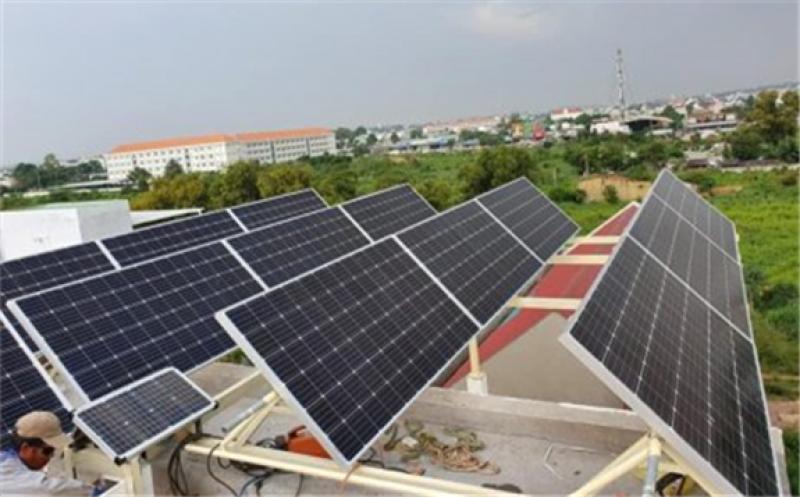In 2014, the installed capacity of non-hydroelectric renewable energy in Vietnam (such as solar, wind and biomass gasification) stood at 109 megawatts (MW), about one third of one percent of the country’s total installed capacity of 34,079 MW. At the time, Vietnam’s electricity mix was dominated by hydropower (46 percent), coal (29 percent) and natural gas (22 percent). By the end of 2019, wind and solar accounted for 5,700 MW of installed capacity, about 10 percent of the total supply. That means Vietnam has seen wind and solar go from essentially zero to 10 percent of its supply in only five years. What is driving this renewable energy boom?

The primary mover is Vietnam’s explosive rate of growth. According to the Asian Development Bank, Vietnam’s economy has grown at 6 percent or more every year since 2014, reaching 7 percent in 2018 and 2019. This rapid growth is driving up energy consumption at an extraordinary rate. The state-owned electric utility, Vietnam Electricity (EVN), has seen the amount of energy sold rise from 128.6 terawatt hours (TWh) in 2014 to 209.4 TWh in 2019. Consumption of electricity has been increasing at more than 11 percent per year, growing at a rate considerably faster than GDP. This is fueling a nearly insatiable demand for more electricity generation and investment.
Vietnam’s historical reliance on hydroelectricity places it at a disadvantage here, as the sustainability of generating energy by damming rivers is limited, and the geopolitics of shared hydropower resources in the region are already fraught. Certainly Vietnam cannot power this level of economic growth indefinitely through hydroelectricity. So what about coal and natural gas, its other main sources of electricity production? As of 2015 Vietnam became a net importer of coal, importing 43.7 million tons in 2019. Imports of natural gas and crude oil have also been rising sharply since 2014.
The bottom line is that domestic production of fossil fuels cannot keep pace with consumption, forcing Vietnam to turn to global markets to secure sufficient raw materials to power its grid. As in the case of Thailand, once a country begins to rely on imports to power its electric grid it is generally when the political class gets serious about transitioning to renewable energy. Vietnam has so far followed this pattern quite closely.
In 2017, Vietnamese regulators authorized EVN to pay an attractive rate of 9.35 cents/kilowatt hour to purchase solar power from independent producers. These types of feed-in-tariffs have shown to be effective inducements for jump-starting growth in renewable energy, under certain conditions. A high tariff alone will not typically get the job done. It must be accompanied with institutional and political support, especially from the implementing agency which in this case is the state-owned utility EVN. Through its subsidiaries, EVN has a monopoly on the transmission and distribution of electricity in Vietnam and has historically controlled around 60 percent of the generating market. Why then did EVN get onboard with these renewable energy ambitions, which require it to cede market share to solar and wind power companies?
Aside from the fact that importing coal and natural gas is driving up the cost of production (which cannot be easily recouped through higher retail rates, as the consumer price of electricity in Vietnam is carefully controlled by the government), it’s part of a much larger effort to push through market reforms in order to make Vietnam more investment friendly. This involves reducing the state’s role in key sectors, and demonstrating that Vietnam is a place where private capital can generate healthy returns.
The government of Vietnam is aware that the country will require large capital inflows to continue underwriting its breakneck pace of economic growth. In the electricity sector alone, EVN’s 2017 Annual Report estimated they would need $22 billion in investment by 2020 to keep pace with demand. Ultimately, this is what has forced such a dramatic shift in the energy sector in such a short time period. On the one hand energy imports are driving up production costs for EVN, and jeopardizing energy security by placing the utility at the mercy of global commodity prices.
At the same time, the country’s political class is eager to expand the role of private capital as a driver of growth, and it knows that in order to do so it must push through reforms in critical sectors historically dominated by state-owned companies. The speed with which EVN has used feed-in-tariffs to onboard renewable energy from private producers should send a positive signal to markets. But it also underscores the fact that when it comes to renewable energy transitions, it is imperative to look beyond mere technical or policy solutions and consider all the political and economic forces that ultimately shape the fate of the sector.
This article is reproduced at thediplomat.com